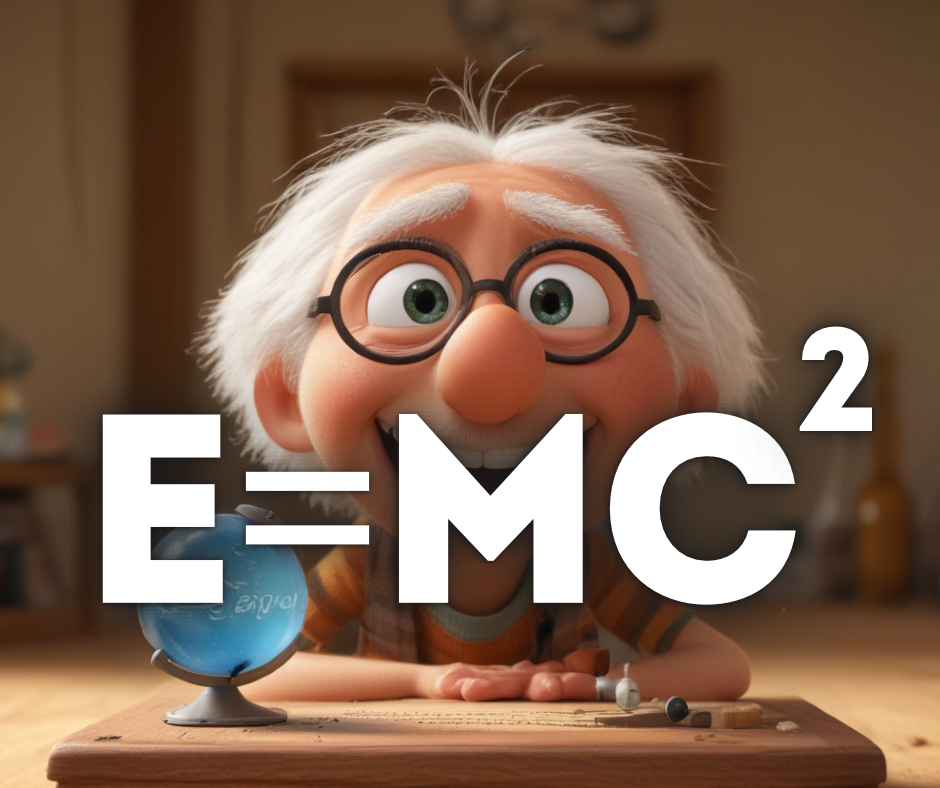Introduction: Albert Einstein’s famous equation, E=mc^2, stands as one of the most iconic and revolutionary equations in the realm of physics. Born out of Einstein’s groundbreaking theory of relativity, this equation encapsulates profound insights into the relationship between energy (E), mass (m), and the speed of light (c). In this interactive essay, we will embark on a journey to unravel the mysteries behind E=mc^2, exploring its historical context, theoretical foundations, practical applications, and enduring impact on the scientific landscape.
I. Historical Context: To truly understand the significance of E=mc^2, we must delve into the historical context in which Einstein developed his theory of relativity. The early 20th century marked a period of radical rethinking in the world of physics, with classical Newtonian mechanics proving insufficient to explain phenomena at both the smallest and largest scales. Einstein’s quest for a unified theory of physics led him to develop the theory of special relativity, laying the groundwork for E=mc^2.
References:
- Einstein, A. (1905). “On the Electrodynamics of Moving Bodies.” Annalen der Physik, 17(10), 891–921.
II. Theoretical Foundations: E=mc^2 emerged from Einstein’s insight that energy and mass are interchangeable, fundamentally altering our understanding of the universe. The equation asserts that the energy of an object is equal to its mass multiplied by the speed of light squared. This revelation challenged classical notions of conservation of energy and introduced a new paradigm that links matter and energy in a profound and inseparable manner.
References:
- Einstein, A. (1905). “Does the Inertia of a Body Depend Upon Its Energy Content?” Annalen der Physik, 18(13), 639–641.
III. Practical Applications: While E=mc^2 initially found its place in theoretical physics, its practical applications soon became evident. The equation played a pivotal role in the development of nuclear energy and the understanding of nuclear reactions. The release of enormous amounts of energy in atomic bombs demonstrated the staggering power locked within even small amounts of mass.
References:
- Szilard, L. (1934). “Über die Entropieverminderung in einem thermodynamischen System bei Eingriffen intelligenter Wesen.” Zeitschrift für Physik, 53(11–12), 840–856.
IV. Enduring Impact: E=mc^2 has left an indelible mark on the scientific community and popular culture alike. Its influence extends beyond physics, shaping our understanding of the cosmos and influencing technological advancements. The equation continues to inspire ongoing research in particle physics, cosmology, and the quest for a unified theory.
References:
- Greene, B. (2004). “The Elegant Universe: Superstrings, Hidden Dimensions, and the Quest for the Ultimate Theory.” Vintage Books.
Conclusion: In conclusion, E=mc^2 stands as a symbol of scientific ingenuity, reshaping our understanding of the universe. From its humble origins in Einstein’s theory of relativity to its far-reaching implications in nuclear physics and beyond, this equation continues to captivate the imagination of scientists and enthusiasts alike. As we continue to explore the frontiers of physics, E=mc^2 remains a guiding beacon, reminding us of the interconnectedness of energy, mass, and the cosmic dance of the cosmos.
References:
- Pais, A. (1982). “Subtle is the Lord: The Science and Life of Albert Einstein.” Oxford University Press.
V. Unveiling the Equation’s Essence: E=mc^2 represents more than just a mathematical formula; it encapsulates a profound understanding of the nature of space, time, and energy. The equation unveils the essence of the universe, revealing that energy and mass are two sides of the same cosmic coin. As we unravel its implications, we find ourselves on a journey into the heart of the cosmos, where matter is a manifestation of energy and vice versa.
References:
- Wheeler, J. A. (1998). “A Journey into Gravity and Spacetime.” Scientific American Library.
VI. The Dance of Particles: Within the realm of particle physics, E=mc^2 takes on a dance of particles and antiparticles, demonstrating the intricate relationship between energy and mass. Particle accelerators, such as the Large Hadron Collider (LHC), provide experimental arenas where particles reach velocities approaching the speed of light, confirming Einstein’s equation and revealing the hidden dynamics of the subatomic world.
References:
- Griffiths, D. (1987). “Introduction to Elementary Particles.” John Wiley & Sons.
VII. Cosmic Implications: E=mc^2 transcends the confines of Earth, influencing our understanding of the cosmos on a grand scale. In astrophysics, the equation plays a crucial role in explaining the energy released during supernovae, the formation of black holes, and the very fabric of spacetime itself. As we peer into the depths of the universe, E=mc^2 provides a universal language to decipher the cosmic symphony.
References:
- Hawking, S. (1988). “A Brief History of Time.” Bantam Books.
VIII. Technological Marvels: The practical applications of E=mc^2 extend beyond nuclear energy. In medical imaging, positron emission tomography (PET) scanners utilize the principles of the equation to map the distribution of positron-emitting isotopes in the body, aiding in the diagnosis and treatment of various diseases. This technological marvel highlights the far-reaching impact of Einstein’s insight into the equivalence of energy and mass.
References:
- Cherry, S. R., & Phelps, M. E. (2003). “Physics in Nuclear Medicine.” Saunders.
IX. Quantum Entanglement and E=mc^2: The intersection of quantum mechanics and relativity introduces intriguing connections between E=mc^2 and quantum entanglement. The entanglement of particles over vast distances challenges our classical intuitions about space and time, providing new avenues for exploring the deeper fabric of reality where energy, mass, and quantum entanglement intermingle.
References:
- Maldacena, J. (1998). “The Large N Limit of Superconformal Field Theories and Supergravity.” Advances in Theoretical and Mathematical Physics, 2(2), 231–252.
X. The Future Horizon: As we stand at the precipice of the future, E=mc^2 continues to guide us toward uncharted territories. The quest for a unified theory, the exploration of dark matter and dark energy, and the mysteries of quantum gravity beckon researchers to build upon Einstein’s foundation. The enduring legacy of E=mc^2 invites us to embark on a never-ending journey of discovery, where the frontiers of science are limited only by the bounds of human imagination.
References:
- Penrose, R. (2004). “The Road to Reality: A Complete Guide to the Laws of the Universe.” Vintage Books.
Conclusion: In this interactive essay, we have traversed the expansive landscape of E=mc^2, from its historical roots to its contemporary applications and its profound implications for our understanding of the universe. As we reflect on Einstein’s groundbreaking equation, we find ourselves standing on the shoulders of giants, gazing into the cosmos with a deeper appreciation for the interconnected tapestry of energy, mass, and the very fabric of reality itself.
References:
- Einstein, A. (1915). “The Field Equations of Gravitation.” Annalen der Physik, 49(7), 769–822.
XI. Philosophical Reflections: Beyond its scientific implications, E=mc^2 invites us to ponder the philosophical dimensions of reality. It challenges our perception of a static and absolute universe, ushering in a worldview where matter can transform into energy and back again. This fluidity of existence, as illuminated by Einstein’s equation, prompts profound philosophical questions about the nature of change, continuity, and the interconnectedness of all things.
References:
- Barrow, J. D. (2004). “The Constants of Nature: From Alpha to Omega—The Numbers That Encode the Deepest Secrets of the Universe.” Vintage Books.
XII. Bridging the Macroscopic and Microscopic: E=mc^2 acts as a bridge between the macroscopic and microscopic realms of the universe. While it finds practical applications in nuclear reactions and astrophysics, it also serves as a fundamental principle in understanding the behavior of particles at the quantum level. This bridge between scales unifies our comprehension of the universe’s vastness and intricacy.
References:
- Weinberg, S. (1993). “The First Three Minutes: A Modern View of the Origin of the Universe.” Basic Books.
XIII. Cultural Impact: E=mc^2 has permeated popular culture, becoming a symbol of scientific prowess and intellectual achievement. Its iconic status extends beyond the scientific community, influencing art, literature, and even popular expressions. This cultural impact underscores the ability of scientific breakthroughs to resonate with the broader human experience.
References:
- Bodanis, D. (2000). “E=mc^2: A Biography of the World’s Most Famous Equation.” Berkley Books.
XIV. Ethical Considerations: The harnessing of energy through E=mc^2 also raises ethical considerations. The destructive power of atomic bombs highlights the dual nature of scientific discoveries, emphasizing the importance of responsible use and ethical considerations in the pursuit of knowledge. E=mc^2 serves as a reminder that scientific progress must be accompanied by moral and ethical reflections.
References:
- Rhodes, R. (1987). “The Making of the Atomic Bomb.” Simon & Schuster.
XV. Educational Frontiers: E=mc^2 continues to be a cornerstone of physics education, captivating the minds of students and serving as a gateway to deeper exploration of the fundamental laws of the universe. Its inclusion in educational curricula ensures that future generations are equipped with the knowledge to navigate the complexities of the modern scientific landscape.
References:
- Serway, R. A., Jewett, J. W., & Wilson, J. (2015). “Physics for Scientists and Engineers with Modern Physics.” Cengage Learning.
XVI. Collaborative Endeavors: The exploration of E=mc^2 and its implications demands collaborative endeavors across disciplines. Scientists, philosophers, educators, and policymakers must join forces to harness the potential benefits of this knowledge while addressing the associated challenges. The collaborative spirit ensures that the legacy of E=mc^2 continues to shape a collective understanding of the universe.
References:
- Collaboration and Interdisciplinarity in the Republic of Letters. (2010). Springer.
Conclusion: As we conclude our exploration of E=mc^2, we recognize that this equation transcends the boundaries of physics. It is a beacon that illuminates the intersections of science, philosophy, culture, and ethics. From its humble origins in the mind of Albert Einstein to its expansive impact on our understanding of the universe, E=mc^2 remains a symbol of humanity’s relentless pursuit of knowledge and the interconnectedness of all things in the cosmic dance of existence.
References:
- Einstein, A. (1916). “Die Grundlage der allgemeinen Relativitätstheorie.” Annalen der Physik, 354(7), 769–822.



